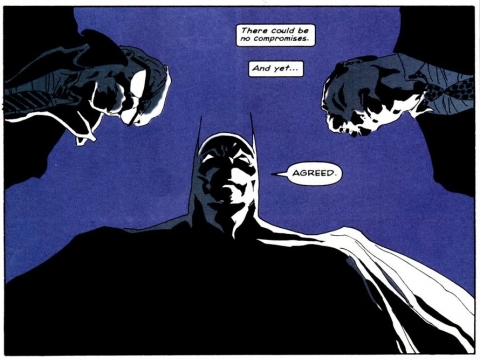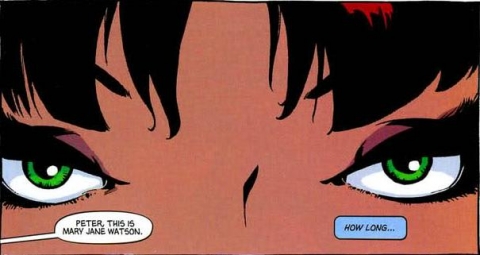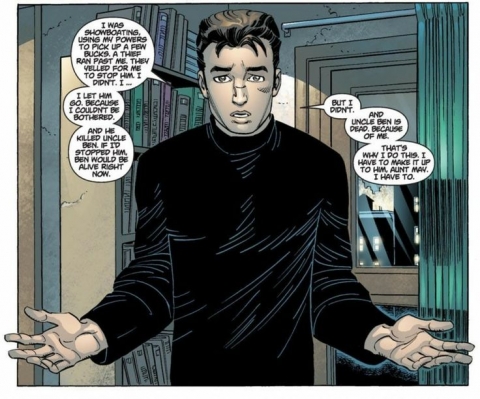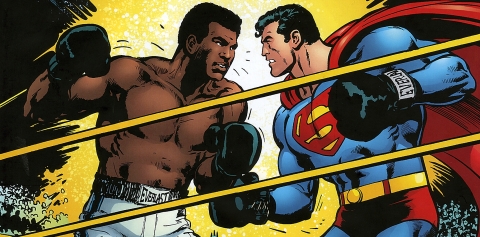52 weeks. 52 different writers. 2 trade paperbacks or hardcovers a week. Each week I’ll take a look at a different writer and read two different collected editions from within that person’s repertoire to help in the examination of their work.
It’s a lot harder than I thought it would be to write an intro paragraph for Jeph Loeb. There isn’t much to say that even infrequent readers may not already know. Jeph Loeb has been a presence in comics for many years, writing plenty of critically acclaimed series (like today’s Batman: The Long Halloween) as well as writing for televisions shows like “Lost” and “Smallville”. Loeb frequently teams with artist Tim Sale, producing one of a kind series for both DC and Marvel. He’s a writer who seems to have just as many fans as he does naysayers, with those who dislike his work targeting for lacking originality or relying on shock value. Regardless of what people think of Loeb as a writer, there’s no denying the important contributions he’s made to the industry, giving stories that have helped to only elevate the creative medium we love today.
Batman: The Long Halloween
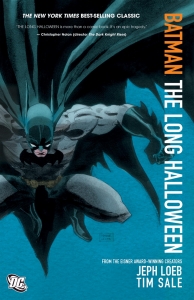 Gotham City stands as a corrupt city, underneath the filthy fingers of Carmine Falcone. Seeking to take down Carmine once and for all, the Dark Knight teams with Commissioner Jim Gordon and District Attorney Harvey Dent. But the city is thrust into a different type of turmoil than it’s used to when a mysterious killer begins targeting the Falcone family. Dubbed the “Holiday Killer”, this murderous villain begins killing members of the Falcone family once a month, with the days they are killed on coinciding with a specific holiday. The end result is one of the most difficult cases Batman has ever worked, plagued by Holiday for over a year as he races against time every month to stop this killer once and for all. Along the way Batman must also combat not only the complex, romantic relationship he shares with Catwoman, but a “who’s who” of some of Gotham’s most vile villains, ranging from the Joker to Solomon Grundy. One thing is for certain, after this string of murders, Gotham City will certainly never be the same again.
Gotham City stands as a corrupt city, underneath the filthy fingers of Carmine Falcone. Seeking to take down Carmine once and for all, the Dark Knight teams with Commissioner Jim Gordon and District Attorney Harvey Dent. But the city is thrust into a different type of turmoil than it’s used to when a mysterious killer begins targeting the Falcone family. Dubbed the “Holiday Killer”, this murderous villain begins killing members of the Falcone family once a month, with the days they are killed on coinciding with a specific holiday. The end result is one of the most difficult cases Batman has ever worked, plagued by Holiday for over a year as he races against time every month to stop this killer once and for all. Along the way Batman must also combat not only the complex, romantic relationship he shares with Catwoman, but a “who’s who” of some of Gotham’s most vile villains, ranging from the Joker to Solomon Grundy. One thing is for certain, after this string of murders, Gotham City will certainly never be the same again.
The dynamite creative force that is Jeph Loeb and Tim Sale bring one of the best mystery stories ever told in the Batman mythos with “The Long Halloween”. Thematically, this story latches on to the idea of holidays and how personal they can be. Holidays are considered special, almost sacred days within the year, wherein you don’t have to work, get time to spend with your family, or simply just celebrate some form of occasion. It’s the almost holy nature of these holidays that makes Long Halloween a fun read, as having murders occur on such special days makes the murders feel as if they’re almost more vile and sacrilegious than they would be if they occurred on the day before, day after, or any random day in between. It’s just pleasant writing to attack the intimacy of something as simple as a holiday through murder and mystery.
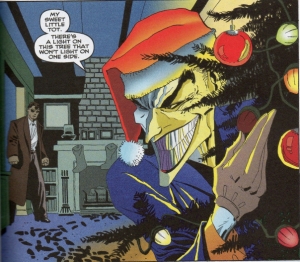 The perfect example of the intimacy of holidays is on full display during three particular chapters in this story; Valentine’s Day, Mother’s Day, and Father’s Day. With Valentine’s Day, it’s fairly apparent why murder is so wrong yet fitting, as it’s a day meant for celebrating love but also a day deeply seeded in violent nature because of the “St. Valentine’s Day Massacre”, a bit of irony that isn’t lost on Loeb or Sale as it is the chapter wherein the most murders and injuries occur while Batman’s love life takes a weird turn. With Mother and Father’s Day, Loeb and Sale do something special, as they touch on how personal of a nature these days have as they pertain to our hero in Batman. As everyone on the planet knows, Batman was orphaned at a young age due to the sudden death of his parents, something that paved the way for his crime fighting career. It’s simply stunning to see the way an emotionally damaged and distraught Bruce Wayne handles himself on Mother’s Day, almost literally running from the pain he feels over the death of his mother before ultimately confronting his father’s death in a tearful confession on Father’s Day. It’s these chapters that show not only how well Loeb and Sale know the character they’re playing with here, but also demonstrate the amount of substance this story has because of how cleverly they approach these holidays in conjunction with Batman and his emotions.
The perfect example of the intimacy of holidays is on full display during three particular chapters in this story; Valentine’s Day, Mother’s Day, and Father’s Day. With Valentine’s Day, it’s fairly apparent why murder is so wrong yet fitting, as it’s a day meant for celebrating love but also a day deeply seeded in violent nature because of the “St. Valentine’s Day Massacre”, a bit of irony that isn’t lost on Loeb or Sale as it is the chapter wherein the most murders and injuries occur while Batman’s love life takes a weird turn. With Mother and Father’s Day, Loeb and Sale do something special, as they touch on how personal of a nature these days have as they pertain to our hero in Batman. As everyone on the planet knows, Batman was orphaned at a young age due to the sudden death of his parents, something that paved the way for his crime fighting career. It’s simply stunning to see the way an emotionally damaged and distraught Bruce Wayne handles himself on Mother’s Day, almost literally running from the pain he feels over the death of his mother before ultimately confronting his father’s death in a tearful confession on Father’s Day. It’s these chapters that show not only how well Loeb and Sale know the character they’re playing with here, but also demonstrate the amount of substance this story has because of how cleverly they approach these holidays in conjunction with Batman and his emotions.
Beyond all the emotion, all the nuance, that can goes missed by readers, there is one thing at the core of Long Halloween that can’t be denied; it’s a fun mystery to try to unfold. With each chapter more characters are introduced and then swept to the wayside, activating a revolving door of potential suspects that will leaving you guessing up until the final pages. Just when you think you’ve got it figured out, your lead suspect is unceremoniously “wacked”, leaving you to retrace your steps and think again on who just might be in frame for these possible murders. The hints are there, brilliantly placed by the simple, artistic style of Tim Sale. It’s the type of story that deserves a second or third read just to pick up on all the clues that were laid down and you never noticed. On top of all this, the payoff in the end is really all worth it. Where the characters go, who wins and loses, it all makes sense and works marvelously in accomplishing what Loeb and Sale wanted to do; entertain you.
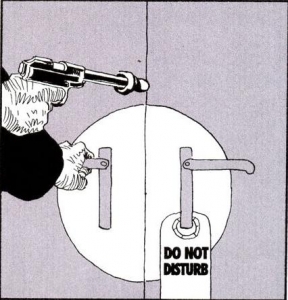 So the emotional core of Batman coupled with the significance of the holidays as a central theme makes The Long Halloween a fairly compelling story. What’s the ingredient that makes it an instant classic though? In my mind, it’s undeniable that the relationship shared between Batman, Jim Gordon, and Harvey Dent is the final piece to elevating this story to heights untouched. It’s mentioned in the foreword how the relationship shared between these three characters actually influenced the trajectory of the hit Batman film “The Dark Knight”. Upon reading this story you can absolutely see why, as the dynamic shared between these three characters is so rich and makes plenty of sense. The three men basically assemble a spectrum of justice, wherein Commissioner Gordon is the far left end, Harvey Dent is the far right, and Batman is smack dab in the middle. Gordon represents the law and the rules that must be adhered to, being the noble voice who sacrifices his own personal gain for the betterment of Gotham. Harvey Dent is the man who embodies justice, responsible for deciding the severity of the punishment and making sure that it is served. Harvey wants to see those doing wrong suffer, within the confines of the law, but still feels as though the law doesn’t necessarily equate to justice (something that serves to be a fundamental part of his villainous counterpart, Two Face). Batman is a gentle balance of both, going outside the confines of the law to bring forth justice but still ensuring that the justice is fair within the confines of the law. To put it simply, and far less wordy, Batman works outside the law to ensure that the law remains in place. The dynamic shared between these three characters is dramatically under appreciated and, to a further point, still remains largely untouched. It blows my mind that someone else hasn’t tried to mine this trio for further fascinating stories because the dichotomy of these three characters together is utterly amazing and should be valued far more highly than it is.
So the emotional core of Batman coupled with the significance of the holidays as a central theme makes The Long Halloween a fairly compelling story. What’s the ingredient that makes it an instant classic though? In my mind, it’s undeniable that the relationship shared between Batman, Jim Gordon, and Harvey Dent is the final piece to elevating this story to heights untouched. It’s mentioned in the foreword how the relationship shared between these three characters actually influenced the trajectory of the hit Batman film “The Dark Knight”. Upon reading this story you can absolutely see why, as the dynamic shared between these three characters is so rich and makes plenty of sense. The three men basically assemble a spectrum of justice, wherein Commissioner Gordon is the far left end, Harvey Dent is the far right, and Batman is smack dab in the middle. Gordon represents the law and the rules that must be adhered to, being the noble voice who sacrifices his own personal gain for the betterment of Gotham. Harvey Dent is the man who embodies justice, responsible for deciding the severity of the punishment and making sure that it is served. Harvey wants to see those doing wrong suffer, within the confines of the law, but still feels as though the law doesn’t necessarily equate to justice (something that serves to be a fundamental part of his villainous counterpart, Two Face). Batman is a gentle balance of both, going outside the confines of the law to bring forth justice but still ensuring that the justice is fair within the confines of the law. To put it simply, and far less wordy, Batman works outside the law to ensure that the law remains in place. The dynamic shared between these three characters is dramatically under appreciated and, to a further point, still remains largely untouched. It blows my mind that someone else hasn’t tried to mine this trio for further fascinating stories because the dichotomy of these three characters together is utterly amazing and should be valued far more highly than it is.
If there was ever to be a complaint about this thrilling Batman tale, it would have to be in regards to the amount of characters introduced. As I pointed out above, the number of characters brought into the story actually keeps you on your toes, never allowing you to comfortably settle into your decision on who Holiday may be. At the same time, the overload of characters can be a bit confusing, with the number of Falcone family members being seemingly infinite whilst you also have to try to remember the members of the rival Maroni family. The further you get into the story, the easier it gets to keep track of characters, as the influx of meaningful characters does slow down considerably but it can still be difficult for some readers to manage two families, plus the Dark Knight, plus the Gordons, plus the Dents, and let’s not forget all the Batman villains who pop up in between everything.
Collects: Batman – The Long Halloween #1-13.
Best Character: Harvey Dent.
Best Line Of Dialogue/Caption: “I believe in Harvey Dent.” – Gilda Dent.
Best Scene/Moment: Bruce speaks honestly about his father (Chapter Nine – Father’s Day).
Best Issue: Chapter Eight – Mother’s Day. It’s hard to pick out just one issue from this collection because it’s like picking out a piece of a puzzle as your favourite piece. Sure the piece may look cool but it works best with the other pieces to actually complete the puzzle. Nonetheless I picked this issue because of how it concludes. It’s taut, filled with a surprising amount of tension as we have a frantic Bruce running from his own life. This issue doesn’t do much for the overall story but I get surprisingly stricken with a sense of helplessness during the finale of this issue every time I read it. If a writer is that good wherein he can make you feel the anxiety of the lead character, then you know you’re reading something special.
Why You Should Read It: You’ll read this because it’s simply one of the best Batman stories ever told and, to a further point, one of the best mystery stories within Batman’s world. Jeph Loeb and Tim Sale do amazing work in just thirteen issues that I feel goes under appreciated because readers get so wrapped up in just reading the story and solving the case with Batman that they miss out on some of the amazing psychology of the work. The theme of the holidays and their importance to Batman, Harvey’s “loose” moral code, Jim Gordon’s difficult dual life, it’s all there for the reader to see, wrapped up in the brilliant trio dynamic shared between the three title characters. Tim Sale’s design work is also utterly flawless on this series. Together Loeb and Sale have crafted one of the finest Batman stories ever written and it’s surely one you can’t miss.
Spider-Man: Blue
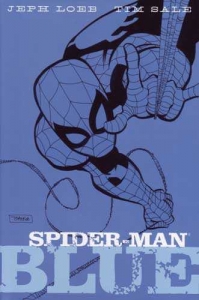 One creator who has become synonymous with Jeph Loeb is his frequent collaborator, Tim Sale. Together the two men have produced countless bestselling series, especially under the Marvel Comics banner wherein they’ve produced multiple “colour” stories for some of the most popular superheroes available to them. Spider-Man, Daredevil, and Hulk have all got the colour treatment, with Captain America actually set to get in on the treatment as well come this fall. The partnership shared between Loeb and Sale goes beyond comics though, as when Loeb was a writer and producer on the show “Heroes”, Sale’s artwork was used repeatedly throughout the shows run, as well having the fonts used in the show modeled after Sale’s style of handwriting. It’s quite difficult to talk about one creator without mentioning the other as the two men are best known for their work with each other. It would be an injustice to do an article about Jeph Loeb’s work without mentioning Tim Sale in the same breath.
One creator who has become synonymous with Jeph Loeb is his frequent collaborator, Tim Sale. Together the two men have produced countless bestselling series, especially under the Marvel Comics banner wherein they’ve produced multiple “colour” stories for some of the most popular superheroes available to them. Spider-Man, Daredevil, and Hulk have all got the colour treatment, with Captain America actually set to get in on the treatment as well come this fall. The partnership shared between Loeb and Sale goes beyond comics though, as when Loeb was a writer and producer on the show “Heroes”, Sale’s artwork was used repeatedly throughout the shows run, as well having the fonts used in the show modeled after Sale’s style of handwriting. It’s quite difficult to talk about one creator without mentioning the other as the two men are best known for their work with each other. It would be an injustice to do an article about Jeph Loeb’s work without mentioning Tim Sale in the same breath.
Peter Parker’s sits in his attic with a tape recorder, talking to the lost love of his life, Gwen Stacey, telling the long dead ex-lover about how he nearly missed his chance to fall in love with her. It all started right around the time he had a climatic showdown with one Norman Osborn, otherwise known as the Green Goblin. Following a fight that burns down a warehouse, Norman Osborn suddenly experiences amnesia and becomes comatose. Peter Parker, under strict orders from the Daily Bugle, is tasked with getting in close to see if Osborn will wake up and snag some pictures while he’s at. What starts out as a selfish task for the Bugle actually leads to Peter befriending Norman’s son, Harry Osborn. As Harry and Peter begin to forge a friendship, Peter is invited into Harry’s group of friends and catches the eye of Gwen Stacey. Immediately stricken by her beauty, Peter is often a bumbling buffoon around her but catches a break when she wants to go on a study date with him. Peter’s love life becomes surprisingly complex with the sudden and unexpected entry of Anna Watson’s niece, the redheaded bombshell, Mary Jane Watson. As the two beautiful women begin to vie for Peter’s affection, his life as Spider-Man becomes equally difficult when all of his major villains seem to be going after him over a price that’s been placed on his head. Little does Peter realize that one of his longtime foes is pulling the strings, attempting to set up his death.
 When it comes to Spider-Man, he’s always had two constants in life: Bad always comes before good, and his love life is always complicated. That’s what’s on full display with “Spider-Man: Blue”, a touching retelling of two love stories simultaneously. I’ve said before during this weekly challenge that, in my opinion, some of the best superhero stories you’ll ever find are the ones that take a character’s history and weave in untold tales that still remain true to the already established history whilst also enhancing it. At its core, that’s exactly what “Spider-Man: Blue” does, as Jeph Loeb and Tim Sale chronicle the evolving love life of Peter Parker during the period where Mary Jane first entered into his life. The end result is a beautiful examination of two of Peter Parker’s most meaningful relationships and how they helped form him into the man he is today.
When it comes to Spider-Man, he’s always had two constants in life: Bad always comes before good, and his love life is always complicated. That’s what’s on full display with “Spider-Man: Blue”, a touching retelling of two love stories simultaneously. I’ve said before during this weekly challenge that, in my opinion, some of the best superhero stories you’ll ever find are the ones that take a character’s history and weave in untold tales that still remain true to the already established history whilst also enhancing it. At its core, that’s exactly what “Spider-Man: Blue” does, as Jeph Loeb and Tim Sale chronicle the evolving love life of Peter Parker during the period where Mary Jane first entered into his life. The end result is a beautiful examination of two of Peter Parker’s most meaningful relationships and how they helped form him into the man he is today.
“Spider-Man: Blue” is basically a retrospective story from the stance of Peter Parker as he talks to a long deceased Gwen Stacey about how, if it wasn’t for her, he likely would’ve never ended up with his “perfect” match in MJ. During this retrospective, Jeph Loeb goes to great lengths to show the reader why either woman was perfect for Peter Parker at the time. You get to see two love stories unfold at the same time, both of which are excellent and a true treat to read for not only Spider-Man fans but for anyone who wants to emotionally invest in characters. Weaving in the romantic woes of Peter Parker with the strain of being Spider-Man and how it affects his personal relationships is exactly why Peter Parker is one of the most well-loved comic book characters ever created. Jeph Loeb and Tim Sale just get that element of Peter right as they show you how badly he wants to commit to one woman or the other but always seems to get pulled away to save the day, as protecting innocent people is far more important than his own needs. Loeb and Sale somehow manage to make you love these characters even more than you thought you could, as you struggle to pick a side, even though you know the decision was already made decades ago.
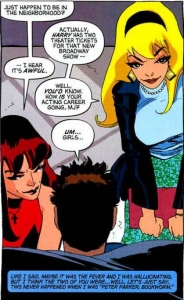 The reason that you can become so engrossed by this love story is largely in part to how well Loeb and Sale characterize your lead females and Peter Parker himself. They take the “old timey”, classic ideals of all these characters but manage to not make any of them feel outdated or cheesy, a feat that is much easier said than done. With Gwen Stacey she is this dynamic force of emotion that has this “girl next door” quality to her whilst also being insanely smart. She’s sharp, witty, and gorgeous but in a way that feels attainable for Peter, making her a more down to Earth option for him in the long run. To contrast that, Mary Jane is everything Peter never thought he could have. She has this hourglass figure that turns every head in any room she enters. Mary Jane is the life of the party, not someone who just attends. She loves to live fast and a bit of danger excites her, making her an obvious match for the Spider-Man side of Peter in some ways. The two
The reason that you can become so engrossed by this love story is largely in part to how well Loeb and Sale characterize your lead females and Peter Parker himself. They take the “old timey”, classic ideals of all these characters but manage to not make any of them feel outdated or cheesy, a feat that is much easier said than done. With Gwen Stacey she is this dynamic force of emotion that has this “girl next door” quality to her whilst also being insanely smart. She’s sharp, witty, and gorgeous but in a way that feels attainable for Peter, making her a more down to Earth option for him in the long run. To contrast that, Mary Jane is everything Peter never thought he could have. She has this hourglass figure that turns every head in any room she enters. Mary Jane is the life of the party, not someone who just attends. She loves to live fast and a bit of danger excites her, making her an obvious match for the Spider-Man side of Peter in some ways. The two
women couldn’t be so similar yet so different at the same time, making it all the harder for you to root for which one you would have loved for Peter to choose back when he actually had any say in the matter. It is how Peter is as a character that makes everything so interesting though, because as different as these two women are from each other, they are both somehow equally perfect for Peter at the exact same time. With Peter’s personality being so loveable and fluid, it’s easy for him to fall in love with both women and for them to fall in love with him. It’s the age-old “Archie Andrews” equation where this goofy guy manages to have two wildly different but equally beautiful women fall in love with him and they’re both perfect for him in such different ways that it’s impossible for him to choose which side wins out.
The romantic elements and character relationships are what carry this story the furthest, while the villainous aspects ultimately fall flat. Before I even go into criticizing that element of the story, let me lead off by saying that anyone who reads this story for just the villains is completely off-base. They couldn’t be more unimportant to what’s actually going on here. The whole point is that this is a LOVE story, with the fact that it’s set in a superhero world being a secondary element. I imagine the need to pack so many different villains into the story was more so of a way to keep the wheels churning and appease comic fans who didn’t just want boy-girl drama for six issues straight. Even though Sale and Loeb still brought that drama, the villains are used as a way to break up the constant “I can’t choose” element of the story, using these villains as a catalyst to move Peter into the next situation that only heightens the difficulty of choosing between Gwen and MJ. The secondary plot of these villains hunting Spider-Man down is fairly average and pays off in an unsatisfying way in the end, feeling rushed and swept to the wayside just to get back to the real meat of the story with Gwen and MJ. Without the villainous element this series would’ve been dramatically shorter but potentially felt too streamlined. In adding the villains in you get a bit of a mystery to distract readers temporary from Peter’s constant love life woes.
Collects: Spider-Man Blue #1-6
Best Character: Mary Jane Watson
Best Line Of Dialogue/Caption: “And I remember being foolish enough to think…let’s fall in love.” – Peter Parker
Best Scene/Moment: Peter Parker in the attic – Issue 6.
Best Issue: Issue 3. We’ll go with issue 3 because this is the first full story with MJ in the series. In one issue we get a complete character summary, telling us who she is, what she wants, and how she lives. For anyone who favours the Peter Parker and MJ relationship, your heart will grow ten sizes while reading this issue. On top of that it also sets up some of the other major parts of this series. Lastly, this issue has a pitch perfect ending for anyone who understands the complexity of Peter Parker’s life.
Why You Should Read It: As a Spider-Man fan this is an essential read as it gently touches on Peter Parker’s complicated love life and “job” as Spider-Man to tell an engaging love story. It’s one of the best depictions you’ll see of the two most important romantic fixtures of Peter Parker’s life, while also showing a great portrayal of a young Peter to boot. Tim Sale’s design work is as great as ever, yet again displaying just a visual knack for making stunning pages. With all that in mind, this story also neatly weaves between important moments of early Spider-Man history, enhancing everything you ever knew about the character and his supporting cast.

